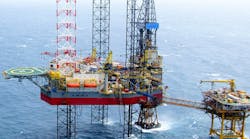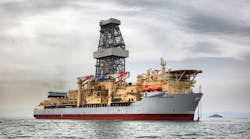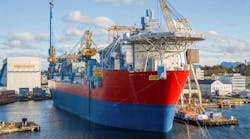Dick Ghiselin • Houston
Jackup rigs have been around for a long, long time. In the evolution of offshore drilling, the only techniques that preceded jackups were submersible rigs and drilling tenders. The latter were flat barges or converted liberty-ships that served as a staging area for all tubulars, the mud system, electrical power generators, and crew quarters. These were connected to a small platform containing the draw works, derrick, and BOP stack. The connector, lovingly referred to as the “widow-maker,” was a suspended catwalk with one-end fixed at the tender’s bow and the other end swaying around as the tender heaved, pitched, and yawed with the prevailing sea and weather conditions. Sometimes the weather was so bad that rig workers elected to sleep curled up on the platform’s drill floor rather than brave the task of leaping to the heaving end of the widow-maker to descend to their hot food and warm bunks.
The first jackups
Canadians argue that they were the true pioneers of the North American oil and gas industry with their discovery well near Chatham, Ontario, a full year before Col. Drake successfully completed his well in Titusville, Pennsylvania. Not only that, but they also built and launched the first jackup rig to drill the Canadian side of Lake Erie in the early 1950s. TheKenting 1 consisted of a land rig erected amidships on a flat barge and was suitable for the shallow, relatively calm waters of the lake. According to reports, the Kenting 1 could drill in water depths up to 150 ft (46 m). The jackup concept placed the rig and all its associated equipment on the vessel. After drilling and completing the well, the rig could jack down and sail away leaving only the wellhead protruding out of the lake’s surface (hopefully with some kind of beacon or sign warning pleasure-boaters to stay away). Economic benefits were immediately obvious. For the first time, the drilling unit was independent and mobile, allowing multiple wells to be drilled by a single self-contained rig.
Unfortunately, theKenting 1 suffered a bitter end, after rig workers failed in 20 attempts to actually jack it up out of the water. Its columnar legs sank into the soft lake bottom. Accordingly, while it could drill as a spud-barge using the legs like mooring posts, it never successfully jacked itself up out of the water, let alone established safe air gap.
Next in line for mobility were the submersible barges and posted barges introduced in the bayous and lakes of south Louisiana. These popular units sat sedately on bottom until the well was completed; then they blew ballast water and floated off to the next job nudged by a shallow-draft tug boat. Some were equipped with giant outboard motor thrusters to give them self-propulsion, but the cost outweighed the convenience.
Interestingly, the jackup concept was introduced by Col. Leon de Long who developed several jackup platforms for Army offshore radar installations. One might say they worked perfectly since a bombing attack of Gulf Coast targets was never suffered during the entire war. Following the D-Day Normandy invasion, de Long extended the jackup idea to provide temporary port facilities on beachheads to aid in supply of ammunition and materials to the invasion force, but these were never built.
With apologies to the ill-fatedKenting 1, the first successful jackup rig was The Offshore Co.’s Rig 51, a 10-leg monstrosity that saw field service from 1954 through 1959.
America’s 41st president, George H. W. Bush, was president of Zapata Offshore and introduced the first triangular-leg jackup design to the field.The Scorpion was completed in 1956 at LeTourneau Shipyards in Vicksburg, Mississippi. Rated at 105 ft (32 m) of water, the rig was capable of drilling to 18,000 ft (5,486 m), which it did until it sank in 1969 while under tow. With a few exceptions, the triangular-leg design captured the bulk of construction contracts for decades.
Present day
Continuing in the three-leg tradition, Cameron has just launched its Jaguar Class self-elevating mobile offshore drilling unit. Featuring the LeTourneau Storm-lok leg fixation system, the Jaguar is capable of operating in 400 ft (122 m) of harsh condition seas, or 500 ft (152 m) in moderate seas. Drilling depth is rated to 40,000 ft (12,192 m) with a 2.5 million lb maximum hook load.
The rig boasts several new features that save time and money without compromising safety. Specifically, the leg fixation system is only needed during severe storm conditions. This allows for half-day savings each time the rig is moved. A unique feature is the ability to lift the individual spud cans out of the water for periodic inspection without dry-docking, potentially saving weeks of downtime and hundreds of thousands of dollars.
Other design features include a cantilever with 1,542 MT (3,400 kip) maximum combined drilling load at its longitudinal reach of 80 ft (24 m) and transverse skidding within ±25-ft (7.6 m) of center. The ability to offer large scale well and workover services is enabled by the rig’s more than 6,800 MT variable deck load at 70-knot winds (5,000 MT variable deck load under severe storm conditions at 100-knot winds).
Boasting storage to well handling of two, 25,000-psi BOP stacks, the rig also features 11 active/reserve mud pits and two slugging pits with combined capacity of 7,770 bbl. Room has been provided for pit-volume expansion later if required. Mud system piping allows for simultaneous use of fresh-, salt-, or oil-based drilling fluid without cross-contamination. Finally, the rig is equipped with automated pipe-handling equipment from rack to downhole, including independent stand-making. •






